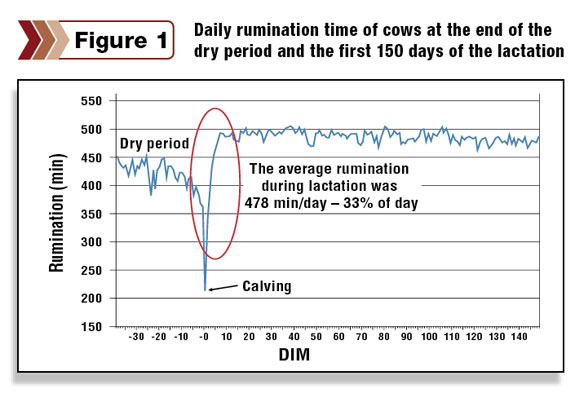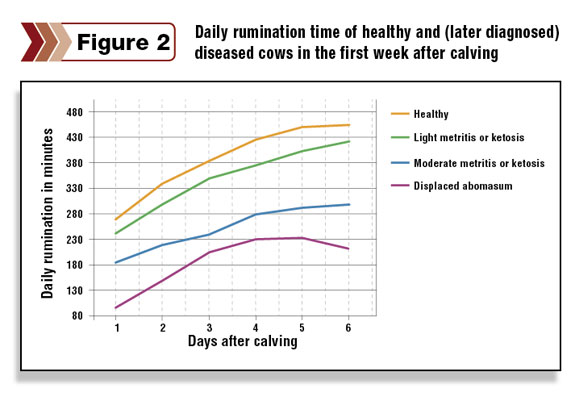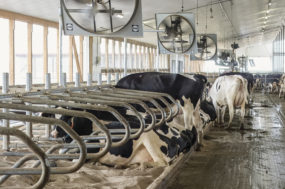It’s never difficult to spot a healthy, content cow. She’s the one chewing her cud after eating comfortably at the feedbunk. For generations, dairy producers, veterinarians and nutritionists have relied on the visual observation of rumination as a monitor of dairy cow health. There’s good reason for this. Rumination is needed for further chewing of hastily eaten food at the feedbunk and for the constant buffering of rumen content. Inadequate rumination will lead to reduced ration digestibility and, consequently, reduced profitability.
Literature repeatedly shows that, on average, cows spend about 35 to 40 percent of their day ruminating. Sick cows don’t spend as much time ruminating as healthy cows. Rumination usually occurs while cows are lying down but also takes place while they do other daily activities like standing, walking and milking.
Early disease prevention
A drop in rumination time often precedes any drop in milk production, so it offers an early window for diagnosis. In other words, producers can monitor rumination time to anticipate potential health concerns before visual signs arise.

According to research conducted in Israel that followed cows from dryoff through 150 days in milk, rumination tends to decrease in the last two weeks before calving, drops suddenly at calving and then rapidly increases postpartum. (See Figure 1)
About a week after calving, cows usually reach maximum daily rumination time, which stays relatively stable for the remainder of the lactation.
By tracking rumination, producers can compare the average daily rumination time on days without any event to days with nutritional changes, health events, calving, estrus and so on.
A clear and significant decrease in rumination is evident on those days when a stressor or activity occurs. Any deviation from a cow’s “normal” trend can indicate the need to evaluate potentially looming health issues. This tracking ability can be particularly useful for early intervention and treatment during the transition period. For example:
• Visible signs of ketosis may not appear until much later than the actual onset of the disease. By monitoring rumination, producers can step in earlier than if just watching for physical signs of ketosis.
• Rumen monitoring may also be helpful to assess a cow’s short-term response to regrouping strategies used in the transition period. This information can then be used to validate current practices or as a basis to adjust future grouping actions.
• Changes in the ration have an immediate impact on rumen health and performance, and rumination monitoring can identify how individual cows respond to the reformulation. This often goes unnoticed when overall herd performance remains the same or improves – but rumination data can help earlier identify potential rumen health issues resulting from ration changes.
There’s an additional economic component to rumination monitoring – a positive correlation between milk fat percentage and rumination rate. As the minutes of rumination per pound of feed intake increase, so does milk fat percentage.
Science behind rumination
It takes time to visually observe rumination and that’s expensive from a labor perspective. Plus, it’s difficult to monitor more than a few animals at a time with any degree of success.
Fortunately, new technology is available to help producers and their management team get the 24/7 rumination information they need to spot potential problems early and offer necessary management interventions to keep cows healthier.
Research published in the December 2009 and January 2011 issues of the Journal of Dairy Science validated the rumination data generated by an electronic tag monitoring system developed in Israel and now available in the U.S. The system uses sounds picked up by a microphone that is in tight contact to the animal’s neck to measure rumination time.
The data is downloaded to and stored in the herd’s computer and is available in individual or group reports. Rumination time is determined after the software recognizes and analyzes the chewing sounds, excluding the sounds related to eating.
Alongside rumination, the electronic system monitors activity, and the two measurements together give comprehensive insight into the cow’s health.

The reports generated can be used to track individual cows or the data used collectively to monitor whole-herd problems (as in the case of unintentional ration changes or inadequate cooling, for example).
Rumination data offers another key tool to make informed management decisions. For instance, producers can improve on health and reproductive protocols by watching data trends to determine appropriate interventions, as well as the timing of these actions – as in the case of transition diseases like ketosis, where rumination time drops before physical symptoms appear. (See Figure 2)
Ultimately, this information provides dairy producers the opportunity to meet the goal of an entire herd of healthy, contented cows. The early identification of potential management challenges helps maximize efficiency and productivity, reduce potential milk production losses and raise the bar for animal health. PD
References omitted due to space but are available upon request. Click here to email an editor.

Tom Breunig
General Manager
SCR Dairy Inc.





